| Article ID | Journal | Published Year | Pages | File Type |
|---|---|---|---|---|
| 1979153 | Current Opinion in Structural Biology | 2011 | 12 Pages |
Deducing the structure of the DNA double helix in 1953 implied the mode of its replication: Watson–Crick (WC) base pairing might instruct an enzyme, now known as the DNA polymerase, during the synthesis of a daughter stand complementary to a single strand of the parental double helix. What has become increasingly clear in the last 60 years, however, is that adducted and oxidatively generated DNA bases are ubiquitous in physiological DNA, and all organisms conserve multiple DNA polymerases specialized for DNA synthesis opposite these damaged templates. Here, we review recent crystal structures depicting replicative and bypass DNA polymerases encountering two typical lesions arising from the oxidation of DNA: abasic sites, which block the replication fork, and the miscoding premutagenic lesion 7,8-dihydro-8-oxoguanine (8-oxoG).
► Oxidation of DNA gives rise to lesions, such as abasic sites or 8-oxoguanine. ► DNA polymerases are then confronted with a modified template during replication. ► Some polymerases utilize protein residues to assist insertion opposite abasic sites. ► In other cases, template looping facilitates synthesis opposite abasic sites. ► Several specialized polymerases incorporate dCMP correctly opposite 8-oxoguanine.
